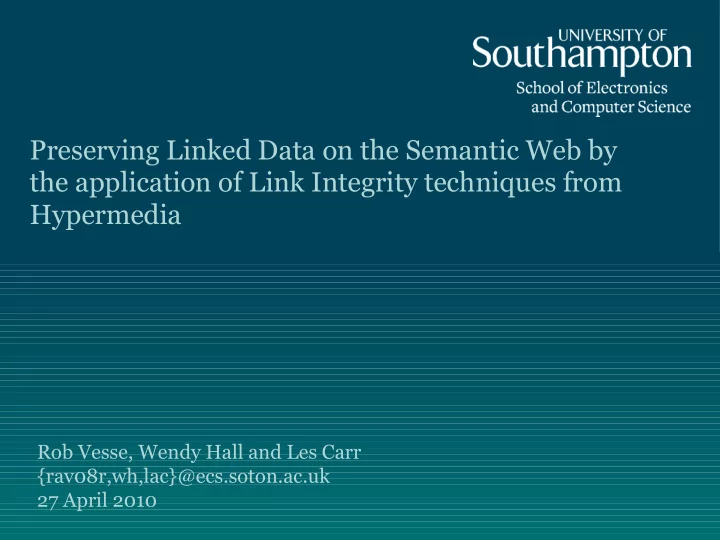

Preserving Linked Data on the Semantic Web by the application of Link Integrity techniques from Hypermedia Rob Vesse, Wendy Hall and Les Carr {rav08r,wh,lac}@ecs.soton.ac.uk 27 April 2010
Link Integrity Aims to ensure that a Link is valid Link is dereferenceable and goes to the intended content Semantic Web introduces additional issues Co-reference Identity & Meaning Two main types of Solution Prevention & Maintenance Recovery 22
Link Integrity in Hypermedia Open Hypermedia Robust Hyperlinks (Phelps & Wilensky 2004) Opal (Harrison & Nelson 2006) Replication & Versioning Community of Agents (Moreau & Gray 1998) RepWeb (Veiga & Ferreira 2003) Memento (Sompel et al 2009) 33
Link Integrity for the Semantic Web Co-reference/Identity CRS (Jaffri et al 2007) – Compute co-references and republish Okkam (Bouquet & Stoermer 2008) – Standardise URIs across applications Maintenance Silk Framework (Volz et al 2009) – Compute links between datasets based on similarity metrics DSNotify (Haslhofer & Popitsch 2009) – Monitors datasets to spot and repair broken links 44
Applying Recovery to the Semantic Web Useful data sources for recovery already available Sindice Cache Data Warehouses e.g. LOD Cloud, Uberlic.org ‘Authoritative’ linking hubs e.g. DBPedia Co-reference services e.g. SameAs.org Possible to exploit the heavy interlinking of the Semantic Web 55
Exploiting Interlinking • Lots of other Click to edit Master text styles datasets refer to its Second level ● Third level URIs ● Fourth level • Use these linkages ● Fifth level to find relevant data to replace the lost data Exploiting Interlinking – What if DBPedia disappeared? • owl:sameAs and rdfs:seeAlso are useful links to follow • DESCRIBE against other datasets SPARQL endpoints also useful for recovering data 66
Expansion Algorithm In essence a crawler which follows links and uses user definable data sources to discover linked data about a URI Works even if the URI itself is unresolvable User can define data sources and services to use using simple RDF vocabulary ● voID with a couple of additions to control the algorithm ● Otherwise defaults to Sindice Cache, DBPedia and SameAs.org Trivially parallel => easily scalable 77
Expansion Algorithm Returns an RDF dataset, each URI we retrieve data from has a corresponding named graph in the dataset Means consuming applications can discard data from sources they don’t trust/unaware of Allows consuming applications to determine how many sources assert a particular statement 88
Applying Preservation to the Semantic Web Provide end users the means to preserve the Linked Data they are interested in Allow them to monitor it over time to preserve changes in the data View change history of data over time Republish the data so other people can use it 99
All About That (AAT) Uses the expansion algorithm to retrieve an RDF dataset about the URI the user wants to preserve ‘Smushes’ the dataset to a single graph while preserving data about the sources which assert each triple Preserves graphs by transforming the original graph into an annotated form Use this as opposed to named graphs as want to annotate at the triple rather than graph level Initial data bloat is a trade off against decreased storage needs over time 1010
All About That (AAT) • Reification is the Click to edit Master text styles basic unit of Second level ● Third level preservation ● Fourth level • Store when we ● Fifth level first and last asserted each triple • Store source(s) for each Triple Triple transformed and annotated using the AAT Schema • Each triple in the RDF Graph to be preserved is transformed into this form • Transformations of all Triples in a Graph form a named graph in AATs Triple Store 1111
All About That (AAT) Data is monitored over time allowing Change Reporting and Versioning Regularly retrieve the linked data for a URI and compare against local annotated data and update Compute the changes and express using Talis ChangeSet Ontology End users can ask to see the data as the system perceived it to be at a given date and time 1212
Future Work Produce larger set of experimental results Detailed analysis of the effectiveness of the expansion algorithm i.e. precision and recall Improving the expansion algorithm Integration with term based search Integration with other link maintenance frameworks e.g. Silk, DSNotify Investigate distributing the algorithm for improved scalability 1313
Questions? 1414
Recommend
More recommend